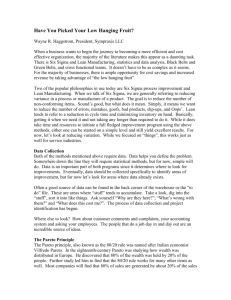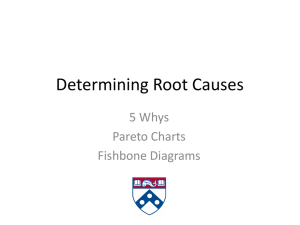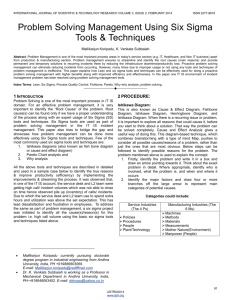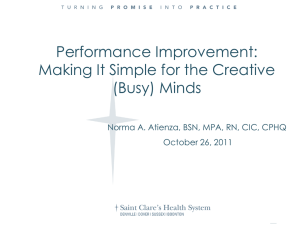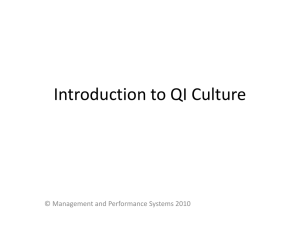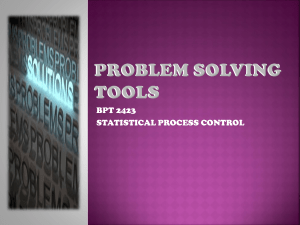4. March 2013 - Root Cause Analysis
advertisement
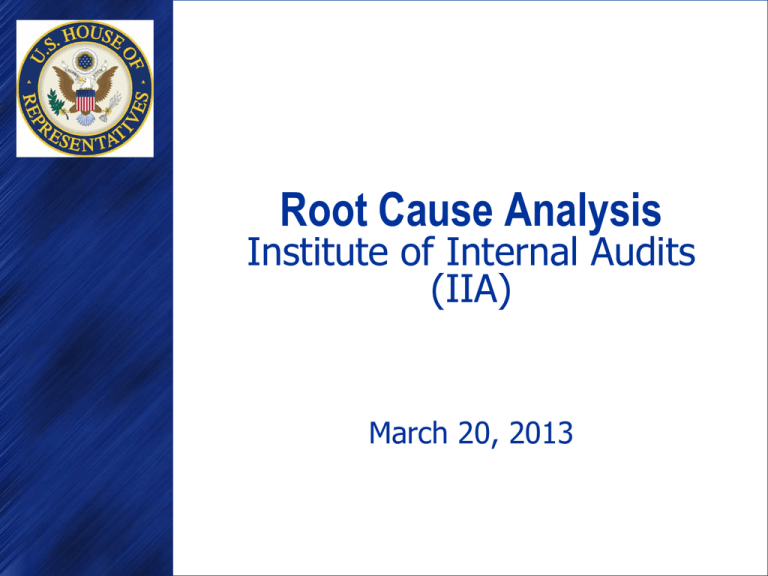
Root Cause Analysis Institute of Internal Audits (IIA) March 20, 2013 Introduction Terry Upshur- Director of Support Services with the Inspector General of the U.S. House of Representatives Lean Six Sigma - Master Black Belt Certified Government Auditing Professional (CGAP) Over 25 Years of Experience in Quality Assurance Root Cause Analysis 2 Super-Bowl Champions Teams with better organizations Teams with better players Teams with better statistics Teams with better records Super-Bowl Championships are based on: Teams with the best execution in the playoffs Baltimore Ravens Root Cause Analysis 3 Overview Performance Improvement Principles Root Cause Analysis Tools and Techniques Closing Remarks Root Cause Analysis 4 Exercise Introduction Scenario # 1 (Answer at the end of the training session) The Plant Manager walked into the plant and found oil on the floor. He called the Foreman over and told him to have maintenance clean up the oil. The next day while the Plant Manager was in the same area of the plant he found oil on the floor again and he subsequentially raked the Foreman over the coals for not following his directions from the day before. His parting words were to either get the oil cleaned up or he’d find someone who would. Copyright © 2004 Gene Bellinger 5 Process Improvement Process Improvement Using the Principles of Lean Six Sigma Root Cause Analysis 6 Lean Six Sigma Is the Integration of Two Powerful Business Improvement Approaches... Lean Six Sigma Speed + Waste Elimination Quality, Cost Goal – Improve performance on items Critical to Customer Quality (CTQs) Focus – Implementing Waste reduction tools Focus – Use DMAIC with (TQM) tools to eliminate variation Method – Improvement events Value Stream Mapping Method – Management engagement, dedicated team effort Goal – Reduce waste and increase process speed Lean Speed Enables Six Sigma Quality (Faster Cycles of Experimentation/learning) Six Sigma Quality Enables Lean Speed (Fewer Defects Means Less Time Spent on Rework) Efficiency Root Cause Analysis Effectiveness 7 What is Six Sigma? Six Sigma is defined as a method to discover customer requirements and meet them with minimal variation. Supported by a suite of quality/statistical analysis tools Concept of Y = f(x1,x2,…) introduced to drive focus on improving critical process inputs rather than just outputs (reports, services, deliveries, sales etc.) Root Cause Analysis 8 Determine Critical X’s (x) Y=f(x) Inputs (Factors) Outputs (Responses) Operating Budget Training Budget System Requirements Number of People Operating Hours Functional Requirements Process: Info Systems Release Customer Interface Skills Selection Root Cause Analysis 9 Y Delivery Time What is Lean? Lean is defined as a process strategy that uses less of everything compared with the traditional process: Less: human effort, space, investment in tools or information. Reduces the number of steps (.90*.90*.90=.72) Removes waste and non-value added processes and complexity Drives speed and increases capacity Root Cause Analysis 10 Lean Focuses on Eliminating Waste Defects Control Process Waste Over Processing Inventory Motion Waiting Root Cause Analysis Transportation 11 Over Production TIMWOOD: An Acronym for WASTE Transportation: Inventory: Transporting something farther than necessary Excess stock of anything Motion: Motion unnecessary to successfully completion the task Waiting: Waiting for anything Over-processing: Processing what the customer doesn’t want. Over-production: Making to much Defects: Root Cause Analysis Work that needs to be redone 12 DMAIC Problem Solving Methodology Define Define the opportunity from both business and customer perspectives Measure Understand the process and its performance Analyze Search for the key factors (critical X’s) that have the biggest impact on process performance and determine the root causes Improve Develop improvement solutions for the critical X’s Control Root Cause Analysis 13 Implement the solution and control plan Value Add – From the Customer Perspective Customer Value Add (CVA) Questions Does the task add form, feature, or function to the process or service? Does the task enable a competitive advantage (reduced price, faster delivery, fewer defects)? Would the customer be willing to pay extra or prefer us over the competition if he or she knew we were doing this task? Example CVA Activities: Improved Safety Shorter Deliver Times Fewer Errors Accurate Reporting Business Value Add (BVA) Questions Does this task reduce owner financial risk? Does this task support financial reporting requirements? Would the process of producing/selling the service break down if this task were removed? Is this task required by law or regulation? Typical BVA Activities: Reconciliations Internal Audits Invoice Processing IRS/OSHA/EPA Reporting Internal Financial Reporting Root Cause Analysis 14 Non-Value Add (NVA) Questions If the customer knew we were doing this, would they request that we eliminate the activity so we could lower our prices? Does the task fit into either of the other two categories? Can I eliminate or reduce this activity? Typical NVA Activities: Over Inspecting Transporting/Moving Stocking/Storing Rework Loops Multiple Signoffs Document Handling Question How does all of this relate to audit? Root Cause Analysis 15 Function of a Finding A finding allows us to understand what occurred, how significant the occurrence was, and how we may be able to reasonably protect against its reoccurrence. Root Cause Analysis 16 Root Cause Analysis and Findings Root cause analysis the elements of a audit findings Criteria – What should be Condition - What does exist Effect – The impact of the difference Cause – Why the difference exist Recommendation – What is a possible remedy? Root Cause Analysis 17 Definition of Root Cause Analysis A process of determining the causes that led to a nonconformance, event or undesirable condition and identifying corrective actions to prevent recurrence which (when solved) restores the status quo or establishes a desired effect. Root Cause Analysis 18 Purpose Root Cause Analysis helps to identify what, how, and why something happened, thus preventing recurrence. Root causes are underlying, are reasonably identifiable, can be controlled by management and allow for the generation of recommendations. The process involves data collection, cause charting, root cause identification, recommendation generation and implementation. Only when you are able to determine why an event or failure occurred will you be able to specify workable corrective measures. Root Cause Analysis 19 Understanding Root Causes To fix a problem it must be clearly defined. In a lot of cases the symptom is identified and not the underlying problem. For example, buying expired milk is not an inspection failure its a recall system failure. Questions to ask are: What is the scope of the problem? What else is affected by the problem? How often does it occur? What impact will this have on the larger population? Root Cause Analysis 20 Determining Root Causes Four steps you can use to identify the Root Cause Data Collection & Prioritization Pareto Analysis Cause Charting Cause and Effect Diagram (Fishbone) Root Cause Identification Recommendation Generation and Implementation Root Cause Analysis 21 Exercise All who are active IIA members (Stand) All that are members of the IIA DC chapter All who have at least two IIA certifications All who have volunteered with the chapter in the last two years All who would like to volunteer with the chapter Root Cause Analysis 22 Data Collection Data collection provides information and an understanding of causal factors. Good data collection techniques involve: Data Types – Attribute or Discrete Good/Bad, Counts or Percentages Planning – When, Who, How, Stratification Check Sheets - Consistency of Data Collection Measurement System Analysis Root Cause Analysis Ensure the data collection process is “Repeatable and Reproduceable” 23 Pareto Chart A Pareto chart is a graphical tool to prioritize multiple problems in a process so you can focus on areas where the largest opportunities exist. Pareto charts are a type of bar chart in which the horizontal axis represents categories of interest. By ordering the bars from largest to smallest, a Pareto chart can help you determine which of the defects comprise the “vital few”, and which are the “trivial many.” The Pareto principle states that 80% of the effect is generated by 20% of the causes. We want to focus on the 20%. Root Cause Analysis 24 Sample Pareto Chart: Processing Errors Pareto Chart of Processing Errors 140 100 120 80 80 60 60 40 40 20 20 0 Exception Count Percent Cum % HHG 73 58.9 58.9 TQ/TA 18 14.5 73.4 GHS 13 10.5 83.9 25 AT 8 6.5 90.3 New Res 7 5.6 96.0 Other 5 4.0 100.0 0 Percent Count 100 Cause Charting Provides a structure for analyzing the information and identifying gaps and deficiencies in knowledge. Cause Charting can also take the form of process mapping. The process map is simply an illustration that depicts the steps or events leading up to an occurrence. Root Cause Analysis 26 Cause and Effect Diagram (Also Called Fishbone) What When A tool to represent the relationship between an effect (problem) and its potential causes by category type. Carried out when a root cause needs to be determined. Why To help ensure that a balanced list of ideas have been generated during brainstorming. To determine the real cause of the problem versus a symptom. To refine brainstormed ideas into more detailed causes. Root Cause Analysis 27 Example: Fishbone Diagram Material Machine Discovery of different discount rates occurs too late in process Methods Computer screens Updates Product Shortages Power Failures Master customer discount table not up-to-date Management Policies Incomplete Training on common complaints Marketing metrics counterproductive Mother Nature Billing process not accurate Too many “jumps” Measurements Manpower Root Cause Analysis 28 Effect: Too many price adjustments at check-out Not enough staffing during peak times Unfamiliarity with procedures For vacation notification Notification of absence Root Cause Identification Use the Cause Charts and subject matter experts (SMEs) to gain a proper understanding of the event. Asking the right questions will help address the actual problem and not the symptoms. Types of questions to ask: What is the scope of the problem? How many problems are there? What is affected by the problem? How often does the problem occur? Root Cause Analysis 29 Root Cause Identification Tools used to assist with Root Cause Identification: Data Analysis Pareto Charts Fishbone Diagrams 5 Why Technique Brainstorming Affinity Diagrams Root Cause Analysis 30 Root Cause Identification Reduce the list of potential root causes Rank root causes using Pareto Analysis (Statistical) Rank the items in order of significance (Organizational) Identify the items with the most significant impact Time Cost Manpower Root Cause Analysis 31 Root Cause Identification Confirm potential root causes relate to the overall problem Validate/Verify that root causes identified have a causal relationship with the desired output Ensure the legitimacy of the measurement system Ensure results are repeatable and reproducible Note: If you cannot state the problem simply, you do not fully understand the problem. Root Cause Analysis 32 Addressing the Root Cause(s) Conduct Value Add Analysis Ensure that items identified will add value to the organization or customer Ensure that the items are required by regulation or policy Confirm that the item does not add value and is not needed or required Root Cause Analysis 33 Recommendation Implementation Things to consider prior to implementation: Determine the impact the root causes will have on critical inputs (X) Estimate impact of the root cause on over-all output (Y) Root Cause Analysis 34 Recommendation Implementation (Management) Implement recommendations based on: Significance to organizational goals and objectives Availability of personnel, finances or other essential resources Complexity of the implementation Evaluate controls required to maintain corrective actions after implementation. Root Cause Analysis 35 Jefferson Memorial See Jefferson Memorial Handout Root Cause Analysis 36 Jefferson Memorial A few years ago National Parks managers noticed the Jefferson Memorial was crumbling at an alarming rate. When they asked why, they found out it was being washed far more often than other memorials. For most organizations, the analysis would stop here. The solution is clear, right? Adjust the cleaning schedule to match those of the other memorials. Unfortunately, that solution would have only led to a very dirty Jefferson Memorial. Because when Parks managers asked about the reason for the frequent washings, they found it had an exceptionally large amount of bird droppings deposited on it every day (no, this isn't a metaphor -- it really happened). What's the solution now? Erect scarecrows? Declare open season on pigeons? Luckily, National Parks managers kept inquiring. And when they asked why the birds seemed to soil Jefferson at rates higher than they did so to Kennedy or Lincoln, they discovered the Virginian's memorial harbored an incredibly large population of spiders upon which the birds were feeding. And the population of spiders had exploded because of an abundance of midges (tiny aquatic insects) in and around the Memorial. By now, you have the routine down. When Parks managers asked why so many midges congregated on the Jefferson memorial, they learned what any fly-fisherman finds out his first day on the river: Midges are stimulated to emerge and mate by a unique quality of light (for the rivers of my home state of Utah, it usually falls between 11 a.m. and 1 p.m. on a cloudy day). It just so happens park managers were inadvertently creating this unique quality of brightness by turning the lights on the memorial just before dusk. This one variable caused the whole chain of events -- lots of midges, lots of spiders, lots of bird droppings, lots of effort on the part of the cleaning crews, and finally, the crumbling of the statue. The solution ended up being pretty simple, and actually saved the Parks Department money: Just wait until dark to turn on the lights. Businessweek March 14, 2006 , Keith McFarland 37 Definition of the 5 Whys The 5 Whys is an iterative question-asking technique used to explore the cause-and-effect relationships underlying a particular problem. The primary goal of the technique is to determine the root cause of a defect or problem. (The "5" in the name derives from an empirical observation on the number of iterations typically required to resolve the problem.) Root Cause Analysis 38 Benefits of the 5 Whys Help identify the root cause of a problem. Determine if there is a relationship between different root causes of a problem. Simplicity; easy to complete without statistical analysis. Effective when problems involve human factors or interactions. Root Cause Analysis 39 Root Cause Analysis Ask "Why?" 5 Times Effect Computer Storage Costs Too High 1. Why? Users keep too many large files as email attachments 2. Why? Users don’t know that this results in an extra charge to the company 3. Why? Email policy not communicated 4. Why? Official email policy not defined ______________ 1. Why? 2. Why? 3. Why? 4. Why? 5. Why? Root Cause Analysis 5. Etc…. 40 5 Why Example Refer Back to Scenario #1 How would you suggest the Plant Manager address the oil on to the floor? Do you see an opportunity to use any of the tools we discussed? See Scenario #2 Root Cause Analysis 41 5 Why Example (Scenario #2) The Plant Manager walked into the plant and found oil on the floor. He called the Foreman over and asked him why there was oil on the floor. The Foreman indicated that it was due to a leaky gasket in the pipe joint above. The Plant Manager then asked when the gasket had been replaced and the Foreman responded that Maintenance had installed 4 gaskets over the past few weeks and that each one seemed to leak. The Foreman also indicated that Maintenance had been talking to Purchasing about the gaskets because it seemed they were all bad. The Plant Manager then went to talk with Purchasing about the situation with the gaskets. The Purchasing Manager indicated that they had in fact received a bad batch of gaskets from the supplier. The Purchasing Manager also indicated that they had been trying for the past 2 months to try to get the supplier to make good on the last order of 5,000 gaskets that all seemed to be bad. The Plant Manager then asked the Purchasing Manager why they had purchased from this supplier if they were so disreputable and the Purchasing Manager said because they were the lowest bidder when quotes were received from various suppliers. The Plant Manager then asked the Purchasing Manager why they went with the lowest bidder and he indicated that was the direction he had received from the VP of Finance. The Plant Manager then went to talk to the VP of Finance about the situation. When the Plant Manager asked the VP of Finance why Purchasing had been directed to always take the lowest bidder the VP of Finance said, "Because you indicated that we had to be as cost conscious as possible!" and purchasing from the lowest bidder saves us lots of money. The Plant Manger was horrified when he realized that he was the reason there was oil on the plant floor. Bingo! Copyright © 2004 Gene Bellinger 42 Table Top Exercise Problem Statement 1: You have to spend more and more money on your utility bills. Problem Statement 2: Your boss is unhappy because he has received work-papers that don’t meet this expectations. Problem Statement 3: You frequently arrive to work late in the mornings and you are faced with disciplinary action if you don’t correct it immediately. Problem Statement 4: You do not have enough money to retire comfortably. Root Cause Analysis 43 Table Top Reporting Each group take 5 minutes to report on 5 Why Exercise What were your questions What were some potential root causes? Root Cause Analysis 44 Closing Remarks Appreciate that Process Improvement is a proven and established methodology that has been successfully implemented by corporate, academic, and government agencies. You have gained an appreciation for the value of Root Cause Analysis and the part it plays in responding to recommendations You have become familiar with the 5 why process and find it useful. Closing Remarks 45 Questions? Terry Upshur terry.upshur@mail.house.gov Closing Remarks 46
